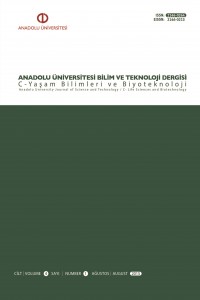Öz
Bu çalışmada ticari olarak temin edilen Rutaceae familyasına ait Citrus reticulata Blanco uçucu yağı fizikokimyasal özellikleri ve kimyasal bileşimi incelenmiştir. Fizikokimyasal özellikleri kapsamında uçucu yağın yoğunluk, kırılma indisi ve spesifik çevirme açısı belirlenmiştir. Ayrıca gaz kromatografisi (GK) ve gaz kromatografisi (GK)-kütle spektrometresi (KS) analizi ile kimyasal bileşimi ortaya konmuştur. Uçucu yağın %99.9’una karşılık gelen 12 bileşik tanımlanmıştır. Ana bileşikler limonen (%73.1) ve g-terpinen (%16.0) olarak tespit edilmiştir. Elde edilen bulgular Avrupa Farmakopesi standartları ile karşılaştırılmış ve incelenen uçucu yağın bu standartlara uygun olduğu belirlenmiştir.
Anahtar Kelimeler
Citrus reticulata Uçucu yağ Gaz kromatografisi-Kütle spektrometresi Limonen
Kaynakça
- Barboni, T., Luro, F., Chiaramonti, N., Desjobert, J. M. Muselli, A., & Costa, J. (2009). Volatile Composition of Hybrids Citrus Juices by Headspace Solid-Phase Micro Extraction/Gas Chromatography / Mass Spectrometry. Food Chemistry, 116(1), 382-390.
- Bhuyan, N., Barua, P. C., Kalita, P., & Saikia, A. (2015). Physico-chemical Variation in Peel Oils of Khasi Mandarin (Citrus reticulata Blanco) During Ripening. Indian Journal of Plant Physiology, 20(3), 227-231.
- Bourgou, S., Rahali, F. Z., Ourghemmi, I., & Saïdani Tounsi, M. (2012). Changes of Peel Essential Oil Composition of Four Tunisian Citrus During Fruit Maturation. The Scientific World Journal, 1-10.
- Chutia, M., Deka Bhuyan, P., Pathak, M. G., Sarma, T. C., & Boruah, P. (2009). Antifungal activity and Chemical Composition of Citrus reticulata Blanco Essential Oil Against Phytopathogens from North East India. LWT - Food Science and Technology, 42(3), 777-780.
- Danielski, L., Brunner, G., Schwänke, C., Zetzl, C., Hense, H., & Donoso, J. P. M. (2008). Deterpenation of Mandarin (Citrus reticulata) Peel Oils by Means of Countercurrent Multistage Extraction and Adsorption/Desorption with Supercritical CO2. The Journal of Supercritical Fluids, 44(3), 315-324.
- Espina, L., Somolinos, M., Lorán, S., Conchello, P., García, D., Pagán, R., (2011). Chemical Composition of Commercial Citrus Fruit Essential Oils and Evaluation of Their Antimicrobial Activity Acting Alone or in Combined Processes. Food Control, 22(6), 896-902.
- ESO 2000, (1999) The Complete Database of Essential Oils, Boelens Aroma Chemical Information Service, The Netherlands. European Pharmacopoeia, (2011) Council of Europe, 7th ed.: Strasbourg, Vol.1, 2011, 1175.
- Frederick S., Davies S. and Albrigo L. Gene., (1994). Citrus. CAB International, Wallingford UK. 30- 33
- Hamdan, D., El-Readi, M. Z., Nibret, E., Sporer, F., Farrag, N., El-Shazly, A., & Wink, M. (2010). Chemical Composition of the Essential Oils of Two Citrus Species and Their Biological Activities. Pharmazie, 65(2), 141-147.
- Hosni, K., Zahed, N., Chrif, R., Abid, I., Medfei, W., Kallel, M., Sebei, H. (2010). Composition of Peel Essential Oils from Four Selected Tunisian Citrus Species: Evidence for the Genotypic Influence. Food Chemistry, 123(4), 1098-1104.
- Joulain D.,. Koenig W.A, (1998) The Atlas of Spectra Data of Sesquiterpene Hydrocarbons, EB-Verlag, Hamburg..
- Kasali, A. A., Lawal, O. A., & Olaniyan, A. A. (2010). Citrus Essential oil of Nigeria Part I: Volatile Constituents of Citrus limon Burm. F. Leaf Oil. Journal of Essential Oil Bearing Plants, 13, 540–544.
- Karioti, A., Skaltsa, H., & Gbolade, A. A. (2007). Constituents of the Distilled Essential Oils of Citrus reticulata and Citrus paradisi from Nigeria. Journal of Essential Oil Research, 19(6), 520–522. http://doi.org/10.1080/10412905.2007.9699320
- Koenig W.A., D. Joulain, D.H. Hochmuth, (2004) Terpenoids and Related Constituents of Essential Oils. MassFinder 3, Hamburg, Germany.
- McLafferty F.W., Stauffer D.B., (1989) The Wiley/NBS Registry of Mass Spectral Data, J Wiley and Sons: New York,.
- Njoroge, S. M., Karanja, P. N., & Sawamura, M. (2008). Essential oil Components of Common Mandarins (Citrus reticulata Blanco) from Uganda. J.Essent.Oil Bearing Plants, 11(6), 609-614.
- Njoroge, S. M., Koaze, H., Mwaniki, M., Minh Tu, N. T., & Sawamura, M. (2005). Essential oils of Kenyan Citrus Fruits: Volatile Components of Two Varieties of Mandarins (Citrus reticulata) and A Tangelo (Citrus paradisi x Citrus tangerina). Flavour and Fragrance Journal, 20(1), 74-79.
- Shaw PE. (1977); Review of Quantitative Analysis of Citrus Essential Oils, Journal of Agriculture and Food Chemistry, 27:246-257.
- Stashenko, E. E., Blanco Tirado, C., Combariza, M. Y., & Martinez, J. R. (1995). Comparative study of Colombian Citrus Oils by High-Resolution Gas Chromatography and Gas Chromatography-Mass Spectrometry. Journal of Chromatography A, 697(1-2), 501-513.
- Tao, N., Jia, L., & Zhou, H. (2014). Anti-Fungal Activity of Citrus reticulata Blanco Essential Oil Against Penicillium italicum and Penicillium digitatum. Food Chemistry, 153, 265-271.
- Viuda-Martos, M., Ruiz-Navajas, Y., Fernández-López, J., & Pérez-Álvarez, J. A. (2009). Chemical Composition of Mandarin (C. reticulata L.), Grapefruit (C. paradisi L.), Lemon (C. limon L.) and Orange (C. sinensis L.) Essential Oils. Journal of Essential Oil Bearing Plants, 12(2), 236-243.
Ayrıntılar
| Birincil Dil | Türkçe |
|---|---|
| Bölüm | Araştırma Makalesi |
| Yazarlar | |
| Yayımlanma Tarihi | 12 Ocak 2016 |
| Yayımlandığı Sayı | Yıl 2015 Cilt: 4 Sayı: 1 |


